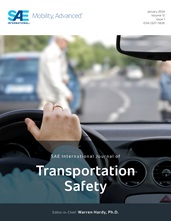A Low-Entry Bus Body Structure Performance under the Conditions of the New Car Assessment Program Frontal Crash Tests
- Features
- Content
- The New Car Assessment Program (e.g., US NCAP and EuroNCAP) frontal crash tests are an essential part of vehicle safety evaluations, which are mandatory for the certification of civil means of transport prior to normal road exploitation. The presented research is focused on the behavior of a tubular low-entry bus frame during a frontal impact test at speeds of 32 and 56 km/h, perpendicular to a rigid wall surface. The deformation zones in the bus front and roof parts were estimated using Ansys LS-DYNA and considered such factors as the additional mass (1630 kg) of electric batteries following the replacement of a diesel engine with an electric one. This caused stabilization of the electric bus body along the transverse axis, with deviations decreased by 19.9%. Speed drop from 56 to 32 km/h showed a reduction of the front window sill deformations from 172 to 132 mm, and provided a twofold margin (159.4 m/s2) according to the 30g ThAC criterion of R80. This leads to the conclusion about the recommendation to reduce the regulatory NCAP speed for city buses to ensure a sufficient safety margin, especially considering the city speed limit of 40–50 km/h. The novelty consists in the application of the NCAP regulations, which is not typical for buses, with the formation of conclusions about the higher danger for passengers compared to UNECE R29 due to the much deeper penetration of plastic deformations into the bus body (up to the rear axle). The obtained results can influence accident prevention strategies and the revision of the city bus certification approaches and regulations.
- Pages
- 17
- Citation
- Holenko, K., Dykha, A., Koda, E., Kernytskyy, I. et al., "A Low-Entry Bus Body Structure Performance under the Conditions of the New Car Assessment Program Frontal Crash Tests," SAE Int. J. Trans. Safety 13(2), 2025, https://doi.org/10.4271/09-13-02-0007.
